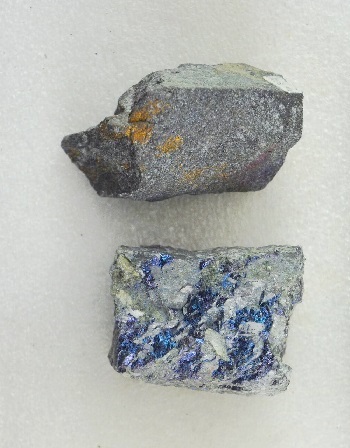The Chronicles Of Grant County
Bornite Street
Tyrone
 Bornite found at the Snowstorm Mine in the Ashcroft Mining District of British Columbia, Canada. (The photograph was provided courtesy of the Pacific Museum of Earth of The University of British Columbia, November 2, 1993.)
Bornite found at the Snowstorm Mine in the Ashcroft Mining District of British Columbia, Canada. (The photograph was provided courtesy of the Pacific Museum of Earth of The University of British Columbia, November 2, 1993.)
Bornite Street is one of the roadways in Tyrone that reflect the mining heritage of Grant County.
Bornite is a sulfide mineral – a copper ore mineral.
It has also been known as "peacock ore" because of its coloring that resembles the colors of the feathers of a peacock.
According to multiple reports, the mineral was discovered by a European in 1725. It went by several different names until 1845. In that year, it was given the name of "Bornite" by a second European. (The original sources for this information have not been located.)
The name of "Bornite" comes from Ignaz Edler von Born (also known as "Ignatius von Born"), a scientist who was born in what is today Romania; at the time of his birth in 1742, this area of Transylvania was part of the Kingdom of Hungary (ruled by the Hapsburg family based in Vienna, Austria). Mr. von Born died in 1791.
He was prominent in scientific research in Europe.
Two items of correspondence between Mr. von Born and Benjamin Franklin, then the United States Minister to France, are in the National Archives of the United States. The letters were dated November 21, 1783, and July 17, 1784; both letters were written in French.
One letter thanked Minister Franklin for "the kindness with which you welcomed..." an individual recommended by Mr. von Born to "the Emperor" to travel to Philadelphia to study natural history.
A note: The "emperor" referred to in the letter to Minister Franklin was likely Joseph II of the Holy Roman Empire. At the time, Austria was ruled by Maria Theresa, Empress of the Holy Roman Empire, Archduchess of Austria, and Queen of Hungary, among other titles.
Bornite was mined in a number of places.
In a news article dated November 4, 1854, The Ipswich Journal included note of a display of Bornite – among other minerals – at a museum exhibit in Suffolk County. This newspaper served Ipswich, a community in Suffolk County, England.
One of the places where Bornite has been mined included southwestern New Mexico. Mining of the ore here appears to have started in the 1800s and continued through the years.
On December 14, 1883, The Black Range of Chloride in Socorro County reported that a gentleman "...brought into the Black Range office a piece of bornite ore weighing about four pounds broken from the croppings of the Midnight lode. It is one of the finest pieces of ore yet shown in the camp."
The Deming Graphic included a news article on June 5, 1914, that stated that "a pocket of rich bornite was recently encountered in one of the upper slopes of the Deadwood mines, the first copper ever discovered in the mine." The Deadwood mining area was in Catron County.
The Western Liberal of Lordsburg reported on December 24, 1915, that "...a smaller mass of rich bornite ore was said to have been found..." at the Nellie Bly Mine in the Pyramid District.
According to the United States Geological Survey (USGS), this mine was located about 7.5 miles south and 25 miles west of Lordsburg. Its primary commodities, noted the USGS, were copper and silver, with gold, lead, and zinc also mined here. Bornite was one of four ores secured from this location.
News reports in the 21st century detailed that people still find bornite in this area of the Land of Enchantment.
Do you have questions about communities in Grant County?
A street name? A building?
Your questions may be used in a future news column.
Contact Richard McDonough at chroniclesofgrantcounty@mail.com.
If your email does not go through, please contact editor@grantcountybeat.com.
© 2023 Richard McDonough